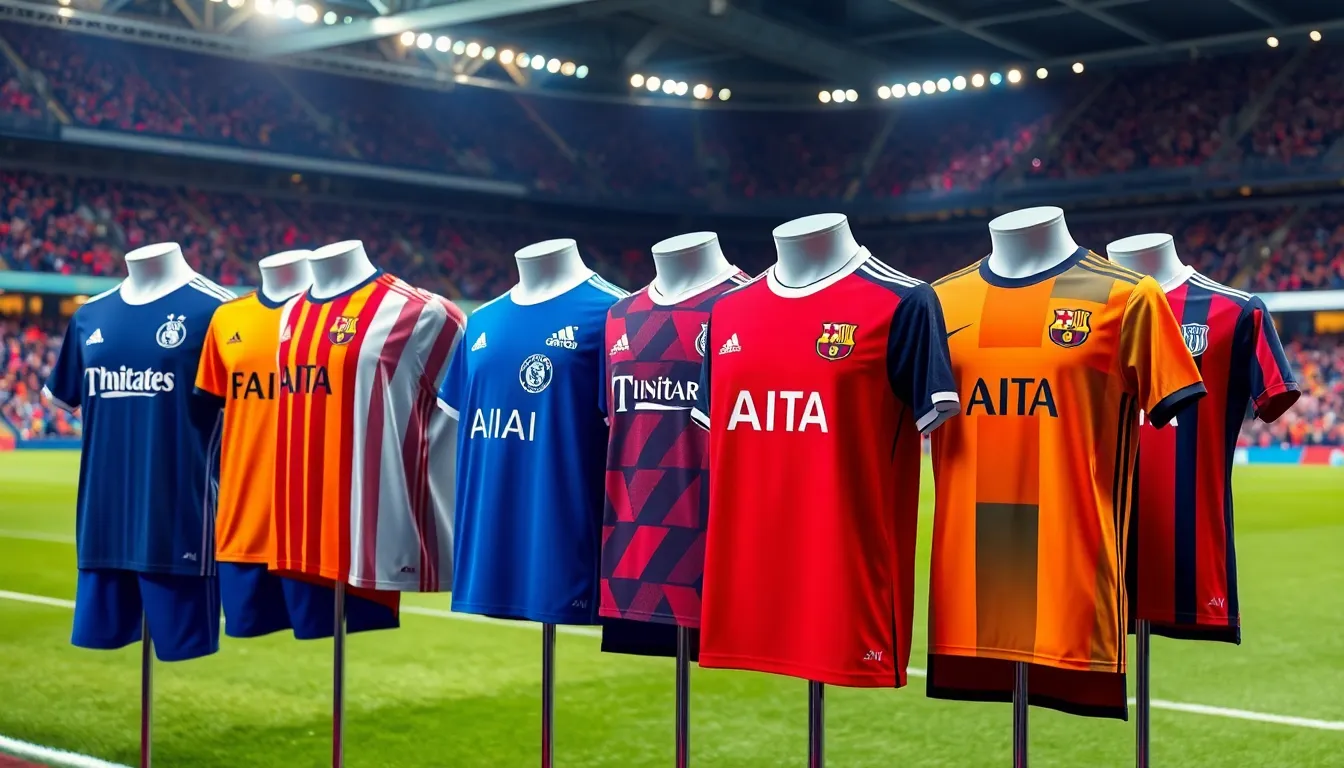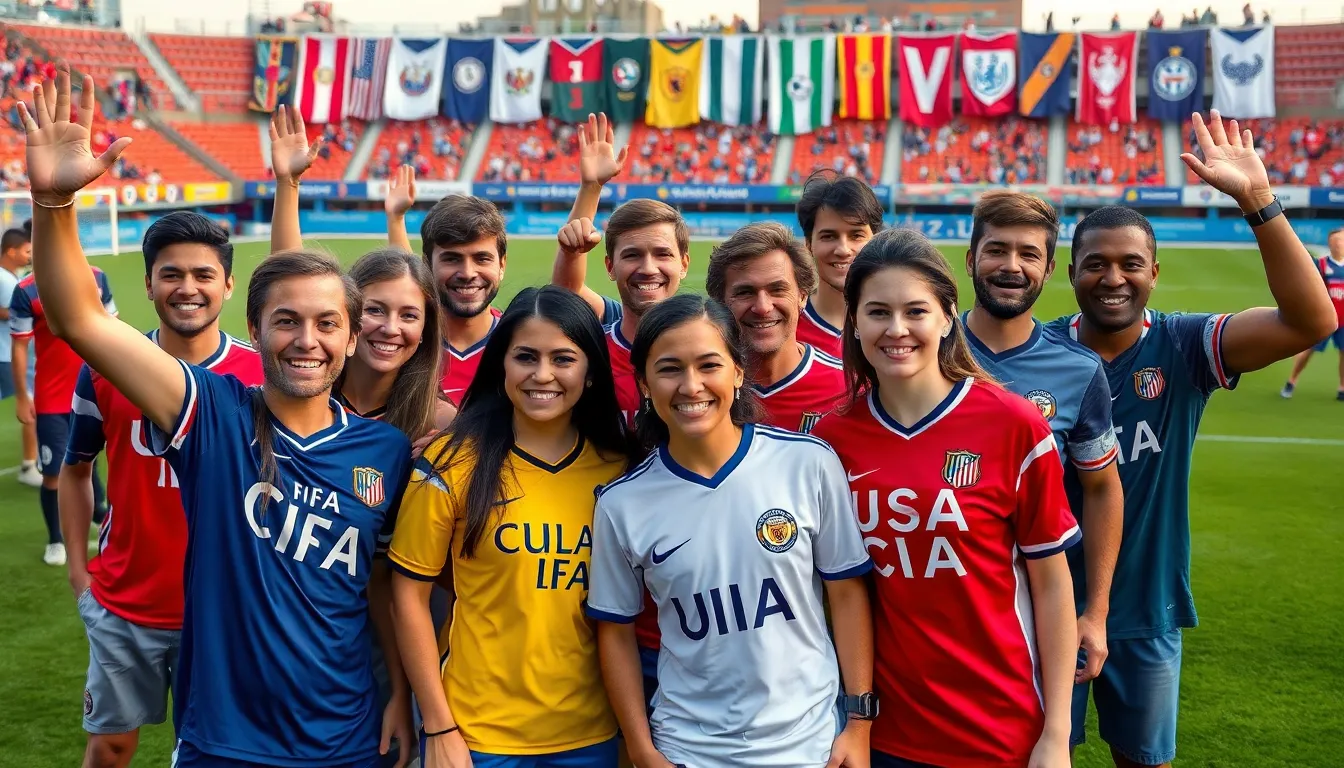Table of Contents
ToggleWhen it comes to FIFA club kits, they’re more than just fabric; they’re a badge of honor, a statement of identity, and sometimes, a fashion faux pas waiting to happen. Fans don’t just wear their team’s colors; they embody the spirit of their club, often with a flair that could make even a runway model envious. From the classic stripes of Juventus to the vibrant patterns of Barcelona, these kits tell stories that go beyond the pitch.
Overview of FIFA Club Kits
FIFA club kits serve as essential components of a team’s brand and identity. They reflect the history, culture, and values inherent within each club. Players don their kits with pride, making a statement on the field that resonates with fans. Different clubs, like Manchester United and Bayern Munich, feature unique designs that tell stories of their legacy and achievements.
Colors play a significant role in club kits. Each color selection symbolizes various elements such as tradition and passion. Supporters connect emotionally to these colors, often wearing them off the pitch as a demonstration of loyalty. The kit’s design can evoke powerful memories, such as iconic matches that solidified a team’s reputation.
Manufacturers collaborate closely with clubs to create these kits, ensuring quality and innovation. Over the years, brands like Adidas and Nike have introduced cutting-edge materials and technologies to enhance performance. Design elements can include intricate patterns, sponsor logos, and player numbers, all thoughtfully integrated to enhance visual appeal.
Seasonal changes also impact club kits. Teams typically unveil new designs for home and away games before the start of each season. Fans eagerly anticipate these announcements, often engaging in discussions about design concepts and color choices on social media platforms. Limited edition kits can generate excitement and become collectibles for supporters.
Ultimately, FIFA club kits embody more than just a uniform. They encapsulate the spirit of football, fostering a sense of belonging among fans while celebrating the pride of their respective clubs. Each kit represents a tapestry of emotions and memories, connecting players with loyal supporters worldwide.
History of FIFA Club Kits

FIFA club kits have evolved significantly since their inception, reflecting the changing dynamics of football culture and design.
Evolution of Designs
Various styles emerged in the early days of football, with teams opting for simple designs that often featured solid colors. Over time, clubs began to adopt unique patterns, logos, and sponsorships, leading to increased brand identity. Teams like Chelsea and AC Milan introduced distinctive color schemes accompanied by bold graphics, showcasing their legacy. The 1970s marked a pivotal moment when club kits began incorporating bold stripes and vibrant colors, setting trends that endure today. Recent seasons feature advanced design techniques that blend tradition with modern aesthetics, captivating fans and encouraging personalization through custom options.
Technological Advancements in Materials
Innovations in materials significantly impacted FIFA club kits, enhancing both comfort and performance. Manufacturers transitioned from basic cotton fabrics to moisture-wicking polyester, improving player performance on the pitch. Advanced designs now incorporate lightweight, breathable materials that regulate temperature effectively. Brands such as Puma and Umbro continuously develop materials that provide flexibility and durability, ensuring kits withstand rigorous demands during matches. Techniques like sublimation printing allow for intricate designs that stand the test of time while maintaining vivid colors, ensuring clubs shine during high-stakes competitions. These advancements align with modern sporting requirements, reinforcing that performance and style go hand in hand for players and fans alike.
Popular FIFA Club Kits
FIFA club kits serve as a visual representation of team identity and culture, showcasing styles that resonate with fans. These kits range from iconic historical designs to contemporary trends that reflect ongoing innovation in football fashion.
Iconic Designs Through the Years
Iconic kits have become synonymous with their clubs. The Manchester United 1999 treble-winning kit remains a favorite among supporters, featuring bold red with striking black accents. Juventus’ 2015 home kit introduced a sleek black-and-white striped design, symbolizing elegance in football. Barcelona’s 2006 kit, known for its vibrant colors and the classic Catalan flag, represents the club’s identity and pride. Over the decades, kits have evolved, with many teams incorporating retro elements into modern designs, creating a nostalgic connection to their rich history.
Current Trends in Club Kits
Current trends in club kits focus on innovation and sustainability. Many brands now utilize eco-friendly materials, like recycled polyester, to align with fans’ environmental values. Minimalist designs with subtle patterns are gaining popularity, as clubs aim for sleek aesthetics that stand out. Additionally, personalized kits featuring player-specific elements foster a deeper connection between the team and its fans. Social media plays a crucial role in shaping these trends, as supporters engage in conversations around new releases and design choices, influencing clubs to embrace unique ideas that attract attention.
The Impact of Club Kits on Fan Culture
Club kits play a significant role in shaping fan culture, influencing identity and community spirit among supporters.
Collecting and Merchandise
Collecting FIFA club kits has become a popular hobby among fans. Enthusiasts often seek out rare editions to display as part of their collections. The rise of online marketplaces allows individuals to buy, sell, or trade vintage kits easily. Limited releases from clubs like Barcelona or Chelsea often prompt a rush among collectors, making these kits highly sought-after items. Merchandise strategies also capitalize on fans’ attachments, with clubs offering replicas and unique designs that resonate with supporters. Many fans proudly showcase their collections at matches, reinforcing their loyalty and connection to the team.
Social Media Influence
Social media platforms significantly impact how fans interact with club kits. Fans frequently share photos and opinions about new releases on platforms like Twitter and Instagram. Clubs leverage these channels to unveil new kits, creating buzz and anticipation within the community. Discussions regarding design choices and player endorsements flourish online, allowing fans to engage directly with the brands. Influencers and fan accounts amplify this discussion, further enhancing the visibility of club kits. As a result, social media not only drives marketing strategies but also builds a sense of belonging among supporters.
FIFA club kits embody the essence of football culture and fan loyalty. They serve as powerful symbols that connect supporters to their teams’ rich histories and traditions. The evolution of these kits reflects not only design innovation but also the deep emotional ties fans have with their clubs.
As manufacturers continue to push the boundaries of performance and sustainability, the excitement surrounding new releases will only grow. The vibrant discussions among fans on social media highlight the significance of these kits in shaping identities and communities. Ultimately, FIFA club kits are more than just apparel; they represent a shared passion that unites fans across the globe.




